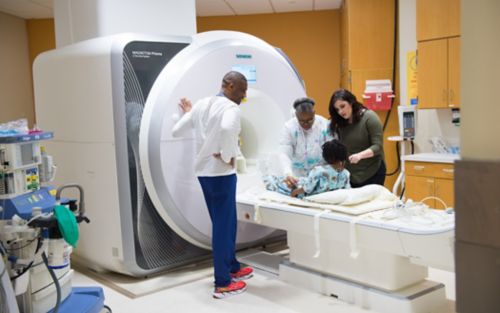There is no single treatment plan for OPG. Because these are usually low-grade tumors, protecting vision is a main concern. Treatment options include observation, surgery, targeted therapy, chemotherapy, and radiation.
Testing of the tumor helps to get the right diagnosis and find the best treatment. But if the tumor is in the nerve behind the eye, doctors must decide if it is safe to get a sample of the tumor for testing or if it should be treated without a biopsy.
Therapies depend on:
- Age of the child
- How much vision was lost
- Tumor location and size
- Whether the child has NF1
Observation of optic pathway glioma
Doctors monitor patients using eye exams and regular MRI scans.
If the disease worsens, the patient may have more vision problems, the tumor may grow larger, or the disease may spread.
Surgery for optic pathway glioma
Surgery is sometimes used to help in the diagnosis and treatment of optic pathway gliomas. Surgery may be done to remove as much of the tumor as possible. Complete removal of the tumor may not be possible, so surgery alone may not provide a cure.
In some cases, doctors may avoid surgery because of the tumor’s location. Risks of surgery include worsening of vision or damage to nearby structures, such as the visual system, pituitary gland, or hypothalamus. Surgery is used less often in patients with NF1.
Targeted therapies for optic pathway glioma
Studies show that most low-grade gliomas have specific genetic mutations in the tumor cells. These gene changes can usually be treated with special medicines called targeted therapies. Targeted therapies work by acting on, or targeting, specific features of tumor cells. In some tumors, there are changes in the genes and proteins that control tumor cell growth and division. Scientists are testing drugs to see if they can block the signals that cause certain cancer cells to grow.
In optic pathway gliomas, changes in the BRAF gene are common. These mutations often occur as a BRAF fusion/duplication or a BRAF V600E mutation. There are drugs that target the BRAF V600E mutation and drugs that target BRAF fusion/duplication (MEK inhibitors). In patients with NF1, the gene mutation is in NF1 gene, and in these cases, MEK inhibitors are used.
Targeted therapies are changing how doctors treat optic pathway gliomas that cannot be completely removed. New medicines that target tumor cells can treat tumors with fewer side effects than traditional chemotherapy or radiation. So, these targeted therapies are becoming the first choice for treatment.
Chemotherapy for optic pathway glioma
Chemotherapy is often used to treat OPGs. It is used in younger patients to delay or avoid radiation therapy. It may also be used when surgery is not a good option or if surgery cannot remove the tumor completely. Not all tumors respond to chemotherapy.
Hearing loss may be a side effect of some type of chemotherapy. Your care team will consider this risk when planning treatments. Patients with OPGs may have vision problems, so avoiding hearing loss is important.
No single chemotherapy plan is used for all OPGs. The medical team will figure out the best plan based on your child’s needs. The plan will depend on factors such as:
- The tumor’s location
- Symptoms
- Your child’s age
- Genetic changes
Some chemotherapy drugs used to treat OPG include vincristine, carboplatin, vinblastine, and lomustine.
Radiation therapy for optic pathway glioma
Radiation therapy may be used for older children depending on the type of tumor and its location. In OPG, radiation therapy is the most effective treatment and helps preserve vision. But there is a risk of late effects, especially for younger patients.




